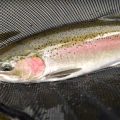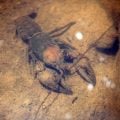How to Tie the SR2 Nymph
Producer: tightlinevideo
I call this fly the SR2 because its primary ingredient is stretch round rib from Wapsi. It’s quick and easy to tie, can be done in a variety of colors, and works exceptionally well—what’s not to like?
The fly starts with a Fulling Mill 5115 barbless hook in size 16, but I’ve had success with the pattern down to an 18 and up to a 12. I’m going to pair this size 16 with a 3/32” black nickel tungsten bead. Plunger-style hackle pliers make getting the bead onto the hook almost foolproof. Just stab the small hole on one of the beads with the hook point, bring the bead up onto the hook shank and get the assembly firmly secured in the jaws of your tying vise.
Here, I’m using the new Hook Jaw by Regal Vise. You can bury the hook point inside the jaws so it doesn’t nick delicate materials or your tying thread. And the jaws permit incredible access to the rear portion of the hook, which really helps with patterns like this one.
For thread, I’ve loaded a bobbin with a spool of black UTC 70. Get the thread started on the hook shank behind the bead and, after taking several wraps rearward, snip off the excess tag.
For the tail of the fly, pull 5 or 6 chocolate brown pheasant tail fibers down, perpendicular to the stem, and strip them free. This should keep their tips aligned. Snipping off the curly little butt ends keeps them from getting caught on your tying thread. While holding the tip ends in your right hand, measure to form a tail about a hook gap in length. Begin securing the fibers to the top of the hook shank with tight wraps of tying thread. Pull slightly up and toward you on the fibers as you go, to keep them centered on top of the shank. Continue taking thread wraps well down into the bend. This is where the hook jaws really come in handy. Do your best to keep the fibers centered on top of the hook shank. Once they’re locked down well, return your thread up the shank to the back edge of the bead, and snip the excess butt ends of the pheasant tail fibers off nice and close.
Brown small stretch round rib is what really sets this pattern apart. Lay one end of the material against the near side of the hook, behind the bead, and take tight wraps with your tying thread to secure it. With it well anchored, pull rearward on the material to stretch it and make it a little bit thinner. Continue binding it to the near side of the hook all the way back to the base of the tail. Then, once again, return your thread forward to right behind the bead.
Get hold of the stretch round rib, put it under a good bit of tension, and begin taking tight touching wraps with it up the hook shank to form the body of the fly. When you reach your tying thread, use it to anchor the material then snip the excess off close. Take a few more securing wraps rearward to make absolutely sure the round rib is well anchored.
Although many materials could be used for the wing case, I really like the 1/8” wide pearl saltwater Flashabou. Snip a strand free from the hank and get hold of one end. Lay that end of the material on top of the hook shank and take wraps of tying thread to begin securing it. Go all the way back to a little bit more than 1/3 of the way down the body of the fly.
Dark brown Australian Possum is used to form the thorax and legs of the fly. Pull a small amount free from the packet and use it to produce a slender 2” long noodle on your tying thread. Take wraps with the noodle to build up a bulbous little thorax on the fly, ending with bare thread at the back edge of the bead.
Get hold of the Flashabou and pull it forward over top of the thorax. While keeping a good bit of tension on the material, bind it down at the back edge of the bead with a few tight wraps of tying thread. Then, pull the forward-pointing portion back and take a few thread wraps over top of that, to lightly pin it back. You can then reach in with your tying scissors and snip the excess Flashabou off close. Don’t worry if there’s a little nubbin sticking up, as it’s better than having that end of the wing case pull free.
Before you whip finish, pick up your favorite dubbing brush and tease out some of the dubbing from both sides of the fly. Then you can pick up your whip finish tool and use it to do a 5 or 6 turn, back to front whip finish, seat the knot well and snip or cut your tying thread free. A drop of head cement, here Sally Hansen Hard as Nails, applied to the thread wraps will ensure they don’t come unraveled once it sinks in and dries. If there are any overly long or wonky-looking fibers of dubbing sticking out, snip them off.
The finished fly should look something like this. And don’t forget you can tie these in a multitude of colors. Remarkably, the SR2 performs especially well when fished in tandem with a smaller Rim Chung’s RS2.
How to Tie the Squirmy Wormy
How to Tie the Stinger Clouser











